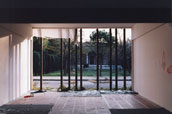Owing to the inquisitive nature of tourism and following our inclinations for contemplation, for parks and for strolling around, we happened once on a winter day into the closed Guardini area in Venice- it was off-season and the Biennale was not there. We discovered the place and its national pavilions unused, in a manner of speaking - because when no art exhibition is taking place, then the pavilions are notably absent of the reason for the park and its property, namely absent of the a world exhibition which every other year fills them with art.
At least, they are absent of the specific artworks which were made by the invited artist to represent the country which has invited them to represent it…further, they are absent of the many visitors which are present when such world-exhibitions are held.
What remains are the park and its architecture. Architecture is like nature: it does not go away. At least as a young person this is how one imagined things. It is strange when architecture changes and begins to move. For example Ruins. A ruin is known to be essentially the remains of architecture which has been moved by changes in outer or inner circumstances – mostly these movements can be traced back to something like time, war, aggression, vandalism, bad weather, bad planning, redirected moneyflow passing by uncompleted buildings, or in a few words: ambivalence towards the architecture. And there, where there are ruins, gaps are formed.
Gaps are also formed between the global event of culture and local ties and realities – a result of the disconnection between everyday normalcy and the contents of artistic expressive forms here once realized and to be realized again, the political discourse that could have been tied to it - all that.
Anyway, now we’re running around in these gaps. Of course one always finds wonderful opportunities in gaps, there is the beginning of the power of imagination; appropriation, takeover, new artworks, utopia, etc.
In the gaps something is always happening. for example among other things: here some people, having either decided for more temporary living conditions or having been forced out of other residence due to political and social circumstance – some people had moved into or squatted some of the pavilions. This alternative usage, along with an obvious counter-energy against societal norms, made visible through graffiti, wall drawings, and other constructive deconstructions. Changes made in the architecture on the one hand rendered the buildings livable, on the other hand opened them entirely to the elements, an effect which soon gave them the characteristics of ruins. From which one could conclude that these objects were made solely in anticipation of the Biennale festivities. Interventions - like the breaking of glass elements, doors and windows, the rearrangement of architectural elements to construct furniture, and last but not least the usage of exhibition space – made place for another idea of festivity aesthetic, etc.
Somehow the new inhabitants, were not present at the time of our visit – one could assume that during the day they were out doing their business or more unfavourably, that they had been discovered and expelled.
In any case, there was no way to exchange feedback with them or with their predecessors. And if we could have, would it have been possible for us all to speak together, knowing ourselves that we were there within the anti-thing, or in the realm of difference – a factor that does determine the expectation of experience, the tourist promise.
But back to the ruins
These gaps that appeared are -to be precise- exactly as temporary as the exhibition itself. They are in effect temporary ruins. Such things are certainly rare in this world. Every two years the movement of the architecture is turned back to the start back to zero, every two years the gap disappears – whatever shape it took and whatever has happened within it. And then - vice versa - the procedure is reversed, the exhibition disappears for two years and the architecture will move. The question remains what is the meaning of this movement and what is the meaning of its absence. It is interesting to think this thought in both directions.
Proprio Aperto, (w/ Judith Hopf, Natascha Sadr-Haghighian). Video 5:30 Min., 2005
